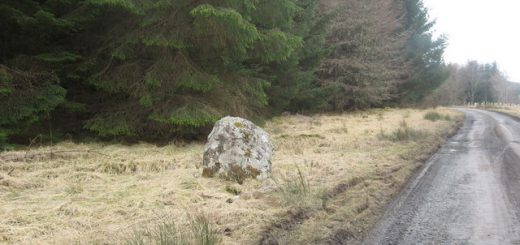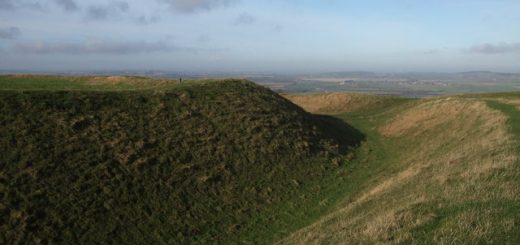The Devil’s Bridge, Burnsall
There stories throughout Britain of the Devil building bridges and Rev Thomas Parkinson in his ‘Yorkshire Legends and Traditions’ (1888) gives the following account for the bridge over the River Dibb at Burnsall.
The highway between Pateley Bridge and Grassington [which is now referred to as the B6265] crosses, in the parish of Burnsall, the deep dell in which runs the small river Dibb, or Dibble, by a bridge known in legend as the Devil’s Bridge. It might reasonably be supposed that Deepdell Bridge, or Dibble Bridge, was the correct and desirable designation, but legend and local tradition will by no means have it so, and account for the less pleasant name in the following manner.
In the days when Fountain’s Abbey was in its prime, a shoemaker and small tenant of part of the Abbey lands, named Ralph Calvert, resided at Thorp-sub-Montem, and journeyed twice a year along this road to pay his rent to the Abbot, dispose of the fruits of his six months handiwork, and return the shoes entrusted to him on his previous visit for repair, and bring back with him, on his return, a bag well filled with others that needed his attention.
The night before setting out, on one of these occasions, he had a fearful dream, in which he struggled with the devil, who, in this wild, rocky ravine, amid unpleasant surroundings, endeavoured to thrust Ralph into a bag, similar to the one in which he carried his stock-in-trade. This he and his wife feared boded no good. In the morning, however, he started on his journey, and duly reached the abbey, assisted at the service, did his business with the abbot and brethren, and then started, with his well-filled bag, on his return homewards. When he arrived near home, in the deep ravine, where on previous occasions he had found but a small brook which he could easily ford, he now found a mountain torrent, through which he only with difficulty and some danger made his way. Having accomplished the passage, he sat down to rest and to dry his wetted garments. As he sat and contemplated the place, he could not but recall how exactly it corresponded with the spot seen in his dream, and at which the author of evil had tried to bag him. Dwelling on this brought anything but pleasant thoughts, and to drive them away, and to divert his mind, he struck up a familiar song, in which the name of the enemy finds frequent mention, and the refrain of which was:
‘Sing luck-a-down, heigh down,
Ho, down derry.’
He was unaware of any presence but his own; but, to his alarm another voice than his added a further line:
‘Tol lol derol, darel dol, dolde derry’
Ralph thought of his dream. Then he fancied he saw the shadow of a man on the road; then from a projecting comer of a rock he heard a voice reading over a list of delinquents in the neighbourhood, with whom he must remonstrate Ralph’s own name among the rest. Not to be caught eavesdropping Ralph feigned sleep; but after a time was aroused by the stranger, and a long conversation ensued, the upshot of which was, after they had entered into a compact of friendship, that Satan informed the shoemaker who he was, and inquired of the alarmed man if there was anything that he could do for him.
Ralph looked at the swollen torrent, and thought of the danger he had lately incurred in crossing it, and of his future journeys that way to the abbey; and then he said, I have heard that you are an able architect; I should wish you to build a bridge across this stream; I know you can do it.’
‘Yes,’ replied his visitant, ‘I can and will do it. At the fourth day from this time, come to this spot and you will be astonished, and you can bring the whole country-side with you, if you like.’
At nightfall Ralph reached his home at Thorpe, and related his adventure to his wife, and added, In spite of all that is said against him, the Evil One is an honest gentleman, and I have made him promise to build a bridge at the Gill Ford on the road to Pateley. If he fulfils his promise, St. Crispin bless him.’
The news of Ralph’s adventure and of the promise soon spread among the neighbours, and he had no small amount of village chaff and ridicule to meet before the eventful Saturday the fourth day arrived. At last it came. Accompanied by thirty or forty of the villagers, Ralph made his way to the dell, where, on arrival, picture their astonishment at the sight! lo, a beautiful and substantial bridge spanned the abyss. Surveyor, and mason, and priest pronounced it to be perfect. The latter sprinkled it with holy water, caused a cross to be placed at each approach to it, and then declared it to be safe for all Christian people to use. So it remained until the Puritan Minister of Pateley, in the time of the Commonwealth, discerning the story to be a Popish legend, caused the protecting crosses to be removed as idolatrous. After. that time, neither the original builder, nor any other person, seems to have thought fit to keep the bridge in ‘good and tenantable’ repair, and in time it fell into so disreputable and dangerous a condition, that the liberal, and almost magic-working, native of the parish Sir William Craven*, Lord Mayor of London in the reign of the 1st James — took the matter in hand, and built upon the old foundations a more terrestrial, but not less substantial and enduring, structure. Still men call it the Devil’s Bridge.
*Sir William Craven (Died 18 July 1618), Lord Mayor of London is possibly who the story of Dick Whittington was based upon. He was born in Appletreewick, Burnsall, which would explain his interest in this Yorkshire bridge.




Recent Comments